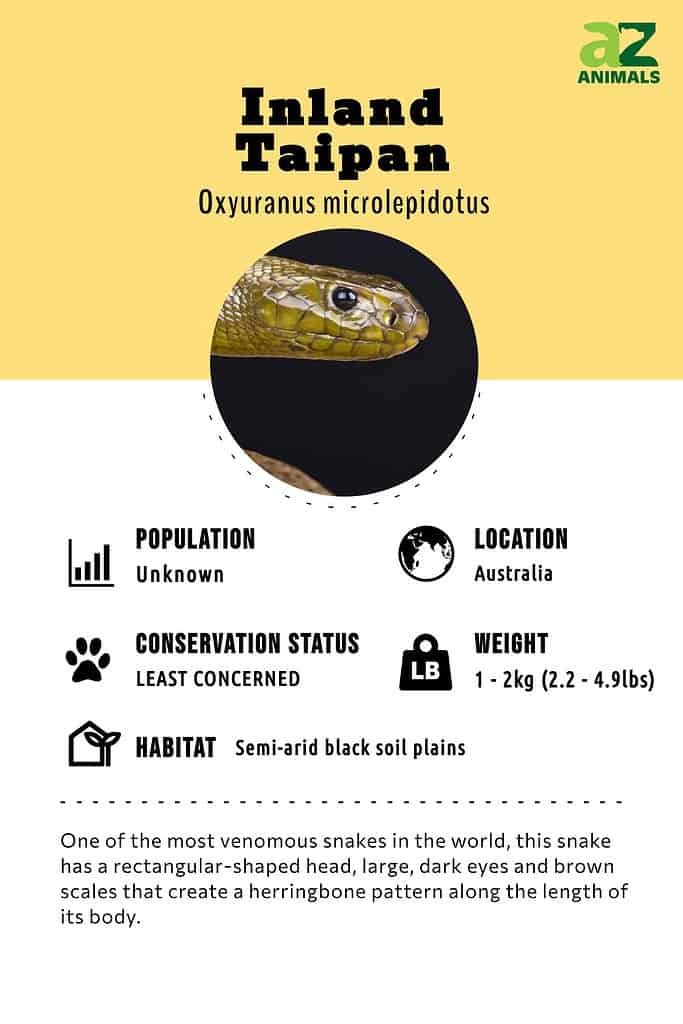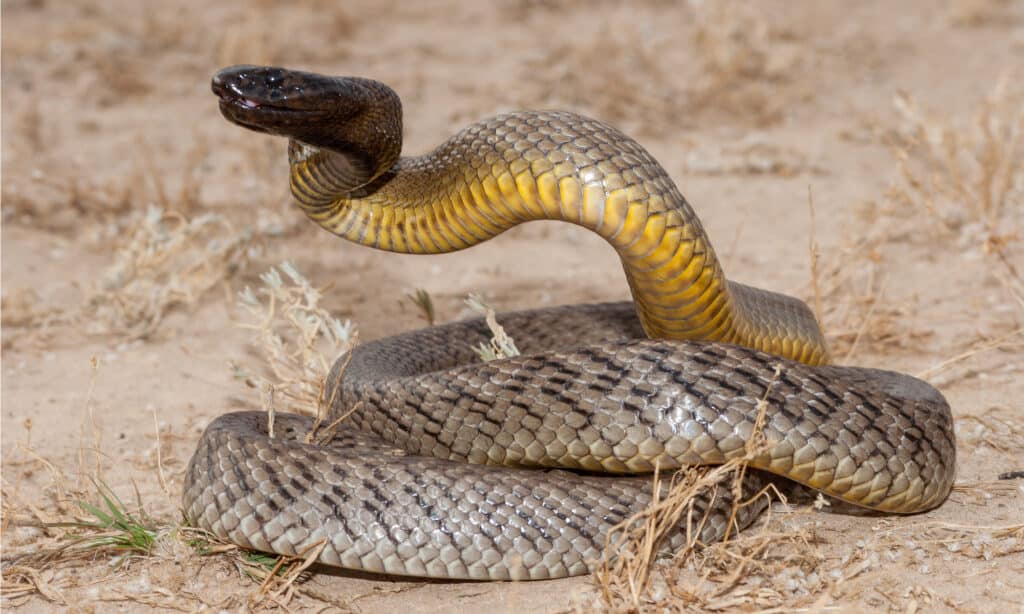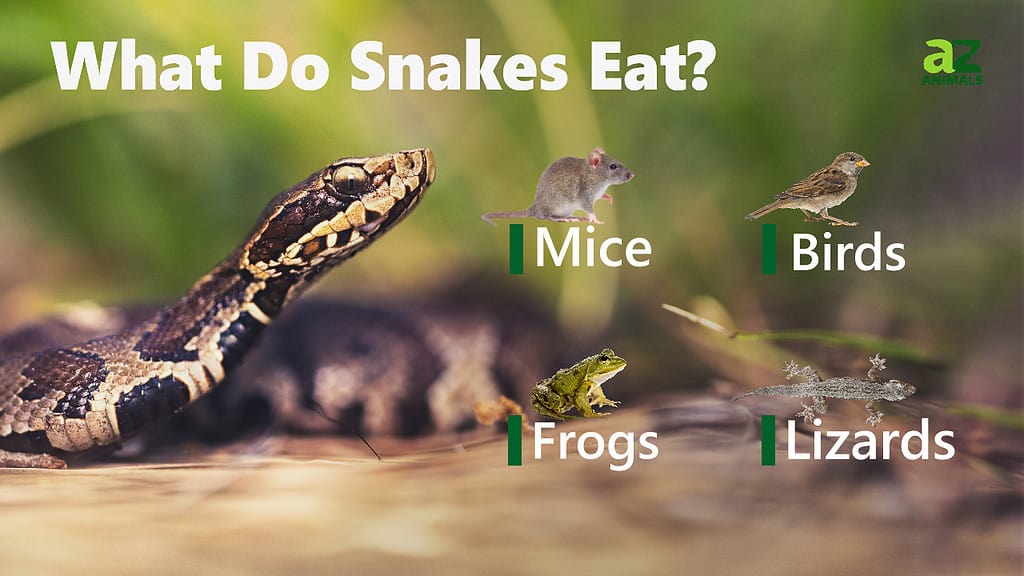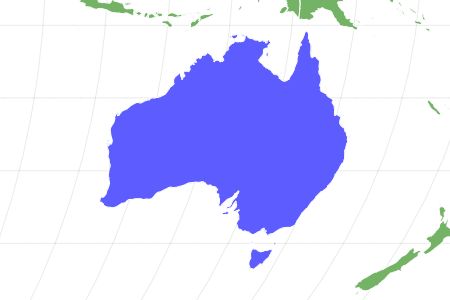Inland Taipan
Oxyuranus microlepidotus
A single inland taipan bite has enough venom to kill a hundred men.
Advertisement
Inland Taipan Scientific Classification
- Kingdom
- Animalia
- Phylum
- Chordata
- Class
- Reptilia
- Order
- Squamata
- Family
- Elapidae
- Genus
- Oxyuranus
- Scientific Name
- Oxyuranus microlepidotus
Read our Complete Guide to Classification of Animals.
Inland Taipan Conservation Status
Inland Taipan Facts
- Prey
- Rodents
- Name Of Young
- Snakelets or hatchlings
- Fun Fact
- A single inland taipan bite has enough venom to kill a hundred men.
- Biggest Threat
- None
- Most Distinctive Feature
- Their scales create a herringbone (zigzag) pattern along the length of the body
- Distinctive Feature
- Rectangular-shaped head and large, round, dark eyes
- Other Name(s)
- Fierce snake, small-scaled snake, or western taipan
- Habitat
- Semi-arid black soil plains
- Predators
- The king brown snake and the perentie monitor lizard
- Diet
- Omnivore
- Common Name
- Inland Taipan
Inland Taipan Physical Characteristics
- Venomous
- Yes
- Aggression
- Medium
View all of the Inland Taipan images!
The inland taipan is thought to produce one of the deadliest venoms in the world.
The inland taipan, also known as the fierce snake, small-scaled snake, or western taipan, can easily kill a person with a single bite, but surprisingly very few deaths have ever been recorded. They will only strike if they feel directly threatened. Nevertheless, this species should be avoided at all costs.

3 Inland Taipan Amazing Facts!
- One of the most interesting facts is that the inland taipan males are thought to engage in combat with each other to compete for mates. During this time, their bodies intertwine, and they lash out at each other with their closed mouths. These snakes are thought to mate in the late winter. Females will lay a clutch of 11 to 20 eggs at a time. In captivity, they can produce two clutches per season. The baby taipans measure about 18 inches long after emerging from the egg.
- The inland taipan has very few predators in the wild. However, the king brown snake and the perentie monitor lizard are both known to feed on baby taipans and juveniles.
- The inland taipan normally lives between 10 and 15 years, but one specimen at the Australia Zoo lived to be more than 20 years old.

Inland taipans can only be found in Australia.
©iStock.com/AlexKosev
Where to Find Inland Taipans
The inland or western taipan is a native of Australia. It can be found in the semi-arid black soil plains habitat of southwestern Queensland and northeastern South Australia in the interior central part of the country. It is presumed to be extinct in Victoria and New South Wales. This snake spends a lot of the hot day hiding in clay cracks or crevasses, so it’s rarely encountered by people.

Inland taipan snakes are native to Australia and are one of three taipan species.
©Ken Griffiths/Shutterstock.com
Scientific Name
The scientific name of the inland or western taipan is Oxyuranus microlepidotus. Oxyuranus essentially translates from Greek to mean sharp or needle-like arch. This refers to the arch-like shape of the snake’s palate on the roof of the mouth. Microlepidotus likewise means small scale in Greek. This species is closely related to the coastal taipan and central ranges taipan, both of which are also native to Australia and New Guinea.
Species
There are three species of Taipan:
- The Inland Taipan (Ocyuranus microlepidotus) – is endemic to semi-arid regions of central east Australia.
- The Coastal Tailpan (Oxyuranus scutellatus) – is native to the coastal regions of northern and eastern Australia and the island of New Guinea.
- The Central Ranges or Western Desert Taipan (Oxyruanus temporalis) – one of the new species named in 2007, this snake was discovered by the curator of the South Australian Museum. The snake, nick-named “Scully” after the X-Files character, turned out to be the first new taipan species to be discovered in 125 years. In 2010, another specimen of O. temporalis was found in the Great Victoria Desert of Western Australia.

Evolution
Fossil records show that snakes first appeared during the Cretaceous period – although they often retained their hind limbs. The earliest true snake fossils come from the marine simoliophiids, the oldest being Hassiophis terasanctus, dated between 112 and 94 million years ago.
Scientists believe that snakes descended from lizards. Pythons and boas, the most primitive snakes, have vestigial hind limbs and some have remnants of a pelvic girdle, appearing as horny projections.
Many modern snakes originated during the Paleocene, alongside the radiation of mammals that occurred after the extinction of non-avian dinosaurs. The expansion of grasslands in North America led to a major radiation of snakes. During the Miocene, the number of snake species increased with the first vipers and elapids and the diversification of Colubridae.

A black mamba can raise 40% of its body off the ground, explaining why most bites are on the upper body.
©Cormac Price/Shutterstock.com
Inland Taipan vs. Black Mamba
The black mamba and inland taipan are both extremely deadly snakes and belong to the same family of Elapidae, but they’re somewhat distantly related to each other. The black mamba is only found in sub-Saharan Africa, not Australia.
Population & Conservation Status
According to the IUCN Red List, the inland taipan is a species of the least concern. Although its range is fairly small and constricted in central Australia, it doesn’t appear to face any significant threats in the wild. Population numbers have never been estimated with any real accuracy.

Inland taipan is the most venomous snake in the world.
©iStock.com/AlizadaStudios
Appearance & Description
The western taipan is a fairly large snake, measuring up to 8 feet long and averaging about 6 feet. It has a rectangular-shaped head and large, round, dark eyes. Males and females are difficult to reliably distinguish from each other. The back can vary anywhere between dark brown and yellowish brown, sometimes with an inky black-blue head, whereas the underside has yellow scales and orange blotches. The scales are colored in such a way as to create a zigzag pattern along the length of the body. These colors will change with the seasons; they become darker in the winter to retain warmth and lighter in the summer to prevent overheating.

The scales of the inland taipan make a herringbone pattern.
©Ken Griffiths/Shutterstock.com
Here is how to identify the inland taipan:
- Long, robust body measuring up to 8 feet in size
- Rectangular-shaped head
- Brown or olive-colored back with a kind of herringbone zigzag pattern
- Yellow underside with orange blotches
Diet

The inland taipan eats mostly mammals in the wild including the long-haired rat and the plains rat. It will sometimes eat baby chicks. The snake’s unusual multiple swift strikes method of killing prey insures success. It is known to deliver as many as eight venomous bites in one attack – delivered fiercely with snapping jaws as it holds its helpless prey steady.
How Dangerous Are They?
The inland western taipan is sometimes cited as the most venomous snake in the world. They’re even more venomous than the blue krait and the king cobra. An untreated bite, which may cause headaches, nausea, vomiting, abdominal pain, and paralysis, has a very high fatality rate of more than 80 percent. Death usually occurs from respiratory failure and suffocation. According to the Australian Zoo, this snake is often said to have enough venom to kill a hundred adult men in a single bite. This is due to its lethal toxicity, the large fangs, and the venom’s fast-spreading action. The inland taipan was found to have the most toxic venom of all snakes in a test on mice. One bite contains enough lethality to kill 100 adult humans.
An extremely swift and agile snake, the inland taipan can strike in an instant with extreme accuracy, often managing multiple strikes in the same attack – releasing venom with every hit.
However, in reality, very few people have ever actually died from this snake, because they’re fairly timid and live in remote locations far from people. Bites almost always occur in a controlled environment where the person already knew they would be handling the snake. Herpetologists, wildlife keepers, and scientists are the most common victims. Despite the very high fatality rate from its bite, the anti-venom usually provides a successful treatment to prevent death, assuming it can be delivered in enough time. Depending on how much of the venom has spread throughout the body, however, recovery can take weeks.

The inland taipan is usually reclusive and prefers to escape rather than fight.
©reptiles4all/Shutterstock.com
Behavior and Humans
Given its deadly nature, the inland taipan is surprisingly mellow and shy around people. Experts have learned how to handle them without being regularly bitten. In the wild, this snake will only attack people if provoked, cornered, or mishandled in some way. It will make a threat display by raising its upper body into a curve and then giving a warning sign. For obvious reasons, anyone who isn’t already working with this snake should avoid it at all costs to prevent an attack.
View all 39 animals that start with IInland Taipan FAQs (Frequently Asked Questions)
Are inland taipans venomous?
Yes, the inland taipan is one of the most venomous snakes in the world. It is also one of the deadliest animals in all of Australia, along with the blue ringed octopus and the sea snake. Baby taipans can start to produce venom shortly after birth.
How do inland taipans hunt?
The inland taipan is an extraordinarily effective hunter. After locating prey through its sense of smell, this snake will attempt to corner the animal in a burrow or crack and then bite them several times in quick succession. The inland taipan strikes with incredible skill and accuracy. It almost never misses. The venom will begin to act within moments so the snake can swallow its prey almost immediately.
Are inland taipans aggressive?
The inland taipan is described as surprisingly tame and mellow in a captive setting, but they will attack and bite if they feel cornered or threatened.
Where do inland taipans live?
This species lives in the hot, semi-arid interior black plains habitats of Australia.
What do inland taipans eat?
The inland taipan primarily consumes rodents. Its entire lifestyle is oriented around the annual boom and bust cycle of the plains rats and house mice in its native habitat.
Can you survive a bite from an inland taipan?
The fatality rate of an untreated bite is extremely high, perhaps more than 80 percent. With proper medical care, however, the prognosis is generally quite good.
Is the inland taipan the most venomous snake in the world?
Studies on rodents have shown that, drop for drop, the inland taipan appears to be the most venomous snake.
How poisonous is an inland taipan?
One of the most interesting facts is that the snake’s bite supposedly has enough venom to kill a hundred people.
How fast can an inland taipan kill you?
Depending on how much venom is injected and the location of the bite, the inland taipan can supposedly kill a person within an hour.
Which is deadlier to humans between the golden dart frog and the inland taipan?
The key attributes determining which is deadlier to humans between the golden dart frog and the inland taipan are venom LD50, how the toxin is introduced, proximity to humans, and human deaths.
Thank you for reading! Have some feedback for us? Contact the AZ Animals editorial team.
Sources
- Austrailian Museum, Available here: https://australian.museum/learn/animals/reptiles/inland-taipan/
- Australia Zoo, Available here: https://www.australiazoo.com.au/wildlife/our-animals/fierce-snake/

















